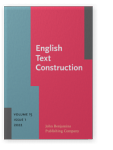Vol. 15:1 (2022) ► pp.68–88
Exploring the use of modality in EFL learners’ writing
Due to prevalence of formal analysis in language education, the implications of Systemic Functional Grammar has largely been ignored by materials and methods of language education. To illustrate the inadequacies of formal analysis and make a case for functional analysis and assessment of writing samples, this study aims at exploring the use of modality in a random sample of expository essays written in an EFL context. To this end, 20 expository essays, written by undergraduate students of English language and literature, were randomly obtained from writing instructors and professors teaching in the English department of Shahrood University of Technology (SUT), Iran. Leaners’ use of modality was then analyzed in line with the framework presented by Halliday & Matthiessen (2014). Analysis revealed learners’ lack of variation in the expression of uncertainties and doubts and as such lack of mastery over modality since they tended to express their opinions as implicit and as objective as possible. There seems to be a link between this problem and the dominance of formal analysis in teaching and assessing writing; hence, the findings of this study have clear implications for teaching instruction in this context and other similar contexts, where the implications of systemic functional grammar for language education seem to be ignored.
Article outline
- 1.Introduction
- 2.Review of related literature
- 2.1Theoretical perspectives on modality
- 3.Empirical findings on modality
- 4.Purpose of the study
- 5.Methodology
- 5.1Research context
- 5.2Research data
- 5.3Data analysis
- 6.Results
- 6.1Interpersonal meaning from the perspective of modality type
- 6.2Interpersonal meaning from the perspective of modality value
- 6.3Distribution of each type of modality orientation
- 7.Conclusion and implications
-
References
